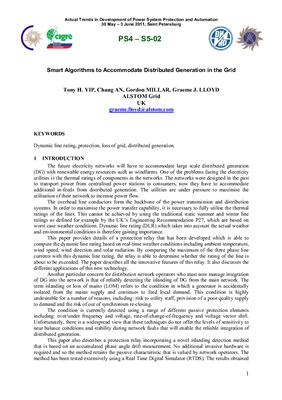ALSTOM Grid UK
The future electricity networks will have to accommodate large scale distributed generation (DG) with renewable energy resources such as windfarms. One of the problems facing the electricity utilities is the thermal ratings of components in the networks. The networks were designed in the past to transport power from centralised power stations to consumers, now they have to accommodate additional in-feeds from distributed generation. The utilities are under pressure to maximise the utilisation of their network to increase power flow. The overhead line conductors form the backbone of the power transmission and distribution systems. In order to maximise the power transfer capability, it is necessary to fully utilise the thermal ratings of the lines. This cannot be achieved by using the traditional static summer and winter line ratings as defined for example by the UK’s Engineering Recommendation P27, which are based on worst case weather conditions. Dynamic line rating (DLR) which takes into account the actual weather and environmental conditions is therefore gaining importance. This paper provides details of a protection relay that has been developed which is able to compute the dynamic line rating based on real-time weather conditions including ambient temperature, wind speed, wind direction and solar radiation. By comparing the maximum of the three phase line currents with this dynamic line rating, the relay is able to determine whether the rating of the line is about to be exceeded. The paper describes all the innovative features of this relay. It also discusses the different applications of this new technology.
The future electricity networks will have to accommodate large scale distributed generation (DG) with renewable energy resources such as windfarms. One of the problems facing the electricity utilities is the thermal ratings of components in the networks. The networks were designed in the past to transport power from centralised power stations to consumers, now they have to accommodate additional in-feeds from distributed generation. The utilities are under pressure to maximise the utilisation of their network to increase power flow. The overhead line conductors form the backbone of the power transmission and distribution systems. In order to maximise the power transfer capability, it is necessary to fully utilise the thermal ratings of the lines. This cannot be achieved by using the traditional static summer and winter line ratings as defined for example by the UK’s Engineering Recommendation P27, which are based on worst case weather conditions. Dynamic line rating (DLR) which takes into account the actual weather and environmental conditions is therefore gaining importance. This paper provides details of a protection relay that has been developed which is able to compute the dynamic line rating based on real-time weather conditions including ambient temperature, wind speed, wind direction and solar radiation. By comparing the maximum of the three phase line currents with this dynamic line rating, the relay is able to determine whether the rating of the line is about to be exceeded. The paper describes all the innovative features of this relay. It also discusses the different applications of this new technology.

